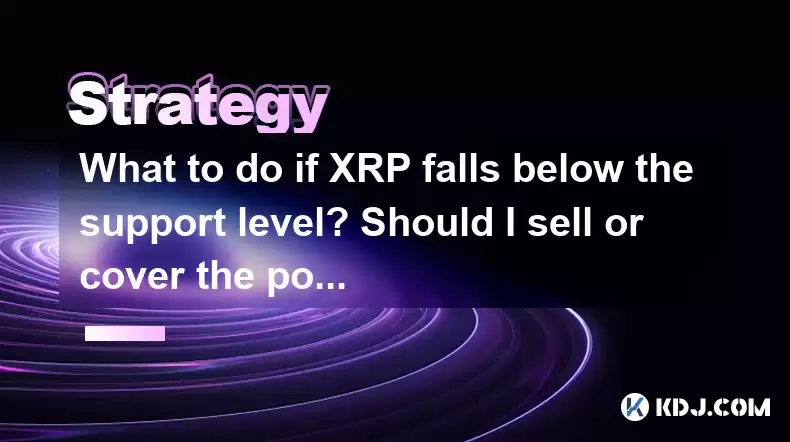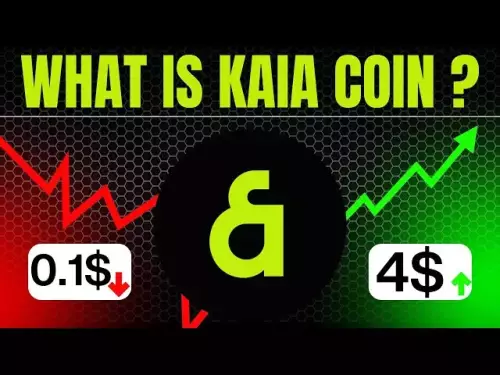-
 bitcoin
bitcoin $112715.707551 USD
-1.71% -
 ethereum
ethereum $4101.475385 USD
-3.01% -
 tether
tether $1.000644 USD
-0.02% -
 bnb
bnb $1207.619465 USD
-6.77% -
 xrp
xrp $2.501451 USD
-3.98% -
 solana
solana $202.947124 USD
-3.32% -
 usd-coin
usd-coin $1.000295 USD
0.04% -
 dogecoin
dogecoin $0.203884 USD
-4.47% -
 tron
tron $0.317154 USD
-1.72% -
 cardano
cardano $0.695009 USD
-4.43% -
 hyperliquid
hyperliquid $38.853961 USD
-8.23% -
 chainlink
chainlink $18.988674 USD
-4.64% -
 ethena-usde
ethena-usde $1.000233 USD
-0.03% -
 stellar
stellar $0.337050 USD
-3.63% -
 bitcoin-cash
bitcoin-cash $536.861728 USD
-1.28%
What to do if XRP falls below the support level? Should I sell or cover the position
If XRP falls below support, assess your strategy: long-term holders may wait for recovery, while short-term traders might sell to minimize losses.
Apr 30, 2025 at 03:09 am

If XRP falls below the support level, it can be a challenging situation for investors and traders. The decision to sell or cover the position depends on various factors, including your investment strategy, risk tolerance, and market analysis. In this article, we will explore the steps you can take if XRP falls below the support level and help you make an informed decision on whether to sell or cover your position.
Understanding Support Levels in Cryptocurrency
Support levels in cryptocurrency trading are price points where a downtrend is expected to pause due to a concentration of demand. When XRP falls below a support level, it often indicates that the selling pressure is stronger than the buying pressure, which can lead to further price declines. Understanding these levels is crucial for making informed trading decisions.
To identify support levels, traders often use technical analysis tools such as trend lines, moving averages, and chart patterns. For instance, if XRP has consistently bounced back from a certain price point in the past, that price point can be considered a support level. When XRP falls below this level, it may signal a shift in market sentiment.
Assessing Your Investment Strategy
Before deciding whether to sell or cover your position, it's essential to assess your investment strategy. Are you a long-term investor who believes in the fundamental value of XRP, or are you a short-term trader looking to capitalize on price movements? Your strategy will significantly influence your decision.
If you are a long-term investor, you might be more inclined to hold onto your XRP despite the price drop. You may believe that the current market conditions are temporary and that XRP will eventually recover. On the other hand, if you are a short-term trader, you might be more focused on minimizing losses and may consider selling or covering your position to protect your capital.
Evaluating Market Conditions
When XRP falls below the support level, it's crucial to evaluate the broader market conditions. Are other cryptocurrencies also experiencing similar declines, or is the drop specific to XRP? Understanding the market context can help you determine whether the price drop is part of a larger trend or an isolated event.
To evaluate market conditions, you can look at various indicators such as trading volume, market sentiment, and news events. High trading volume during a price drop can indicate strong selling pressure, while positive news events might suggest that the price drop is temporary. By analyzing these factors, you can gain a better understanding of the market dynamics and make a more informed decision.
Deciding to Sell XRP
If you decide to sell XRP after it falls below the support level, you need to consider the timing and execution of your trade. Selling at the right time can help you minimize losses and protect your capital. Here are some steps to follow if you choose to sell:
- Monitor the Price: Keep a close eye on the XRP price to identify the best time to sell. You might want to set a stop-loss order to automatically sell your XRP if the price drops to a certain level.
- Assess Your Portfolio: Consider how selling XRP will impact your overall portfolio. If XRP constitutes a significant portion of your holdings, selling it might help you rebalance your portfolio and reduce risk.
- Execute the Trade: Once you've decided to sell, execute the trade through your chosen trading platform. Make sure to double-check the order details to avoid any mistakes.
Deciding to Cover Your Position
If you have a short position on XRP and it falls below the support level, you might consider covering your position to lock in profits or limit losses. Covering a short position involves buying back the XRP you sold short. Here are some steps to follow if you choose to cover your position:
- Evaluate Your Short Position: Assess the performance of your short position and determine whether it's time to cover. If the price drop has resulted in significant profits, you might want to cover your position to lock in those gains.
- Monitor the Price: Keep an eye on the XRP price to identify the best time to cover your position. You might want to set a buy order to automatically cover your position if the price reaches a certain level.
- Execute the Trade: Once you've decided to cover your position, execute the trade through your chosen trading platform. Make sure to double-check the order details to avoid any mistakes.
Considering Other Options
Apart from selling or covering your position, there are other options you can consider when XRP falls below the support level. For instance, you might decide to hold onto your XRP and wait for a potential recovery. Alternatively, you could use this opportunity to diversify your portfolio by investing in other cryptocurrencies or assets.
If you choose to hold onto your XRP, it's essential to have a clear exit strategy in place. Set price targets and stop-loss levels to help you manage your risk and make informed decisions. Additionally, stay updated on market news and developments that could impact the price of XRP.
Frequently Asked Questions
Q: How can I identify a support level for XRP?A: To identify a support level for XRP, you can use technical analysis tools such as trend lines, moving averages, and chart patterns. Look for price points where XRP has consistently bounced back in the past, as these can indicate strong support levels.
Q: What are the risks of holding onto XRP after it falls below the support level?A: Holding onto XRP after it falls below the support level can be risky, as it may continue to decline in value. If the market sentiment remains bearish, you could face further losses. It's essential to have a clear exit strategy and risk management plan in place.
Q: Can I use stop-loss orders to manage my XRP position?A: Yes, you can use stop-loss orders to manage your XRP position. A stop-loss order automatically sells your XRP if the price drops to a certain level, helping you limit potential losses. Make sure to set the stop-loss level carefully based on your risk tolerance and market analysis.
Q: How can I diversify my portfolio if XRP falls below the support level?A: If XRP falls below the support level, you can diversify your portfolio by investing in other cryptocurrencies or assets. Consider allocating your capital to different sectors or asset classes to spread your risk. Research and analyze potential investments to ensure they align with your investment strategy and goals.
Disclaimer:info@kdj.com
The information provided is not trading advice. kdj.com does not assume any responsibility for any investments made based on the information provided in this article. Cryptocurrencies are highly volatile and it is highly recommended that you invest with caution after thorough research!
If you believe that the content used on this website infringes your copyright, please contact us immediately (info@kdj.com) and we will delete it promptly.
- MEXC's Explosive Growth: Trading Volume and Token Gains in Focus
- 2025-10-15 18:25:16
- Pudgy Penguins Price Prediction: Bull Flag Hints at Breakout!
- 2025-10-15 18:45:14
- GateToken Q3 2025 Onchain Destruction: Deflationary Strategy in Action
- 2025-10-15 18:45:14
- Chainlink (LINK): Super Bullish Signals Amidst Institutional Adoption
- 2025-10-15 18:25:16
- Coinbase's India Crypto Play: A Bullish Bet on CoinDCX and the Future of Digital Assets
- 2025-10-15 18:30:01
- Ripple's African Custody Network: A Game Changer?
- 2025-10-15 18:50:01
Related knowledge

Practical parameter settings for a Bitcoin multi-timeframe moving average system
Sep 18,2025 at 10:54pm
Optimizing Timeframe Combinations for Bitcoin Trading1. Selecting appropriate timeframes is crucial when building a multi-timeframe moving average sys...

How can I filter out false breakouts in Dogecoin high-frequency trading?
Sep 22,2025 at 01:00am
Understanding False Breakouts in Dogecoin Trading1. A false breakout occurs when Dogecoin's price appears to move beyond a defined support or resistan...

Techniques for identifying tops and bottoms in the Bitcoin on-chain NVT model
Sep 20,2025 at 07:54pm
Understanding the NVT Model in Bitcoin Analysis1. The Network Value to Transactions (NVT) ratio is often described as the 'P/E ratio' of the cryptocur...

What does the surge in open interest in Bitcoincoin futures mean?
Sep 20,2025 at 11:18pm
Understanding the Surge in Dogecoin Futures Open Interest1. A surge in open interest within Dogecoin futures indicates a growing number of active cont...

How can I use the Ethereum USDT premium to gauge market sentiment?
Sep 18,2025 at 11:55pm
Understanding the Ethereum USDT Premium1. The Ethereum USDT premium refers to the price difference between USDT (Tether) traded on Ethereum-based plat...

What should I do if Ethereum staking yields decline?
Sep 20,2025 at 06:18am
Understanding the Causes Behind Declining Ethereum Staking Yields1. The Ethereum network transitioned to a proof-of-stake consensus mechanism with the...

Practical parameter settings for a Bitcoin multi-timeframe moving average system
Sep 18,2025 at 10:54pm
Optimizing Timeframe Combinations for Bitcoin Trading1. Selecting appropriate timeframes is crucial when building a multi-timeframe moving average sys...

How can I filter out false breakouts in Dogecoin high-frequency trading?
Sep 22,2025 at 01:00am
Understanding False Breakouts in Dogecoin Trading1. A false breakout occurs when Dogecoin's price appears to move beyond a defined support or resistan...

Techniques for identifying tops and bottoms in the Bitcoin on-chain NVT model
Sep 20,2025 at 07:54pm
Understanding the NVT Model in Bitcoin Analysis1. The Network Value to Transactions (NVT) ratio is often described as the 'P/E ratio' of the cryptocur...

What does the surge in open interest in Bitcoincoin futures mean?
Sep 20,2025 at 11:18pm
Understanding the Surge in Dogecoin Futures Open Interest1. A surge in open interest within Dogecoin futures indicates a growing number of active cont...

How can I use the Ethereum USDT premium to gauge market sentiment?
Sep 18,2025 at 11:55pm
Understanding the Ethereum USDT Premium1. The Ethereum USDT premium refers to the price difference between USDT (Tether) traded on Ethereum-based plat...

What should I do if Ethereum staking yields decline?
Sep 20,2025 at 06:18am
Understanding the Causes Behind Declining Ethereum Staking Yields1. The Ethereum network transitioned to a proof-of-stake consensus mechanism with the...
See all articles


























![Staking ATH: How To Stake $ATH in October 2025 with 523% APY — [Step-By-Step Guide] Staking ATH: How To Stake $ATH in October 2025 with 523% APY — [Step-By-Step Guide]](/uploads/2025/10/15/cryptocurrencies-news/videos/staking-ath-stake-ath-october-apy-stepstep-guide/68eef94d80903_image_500_375.webp)















































